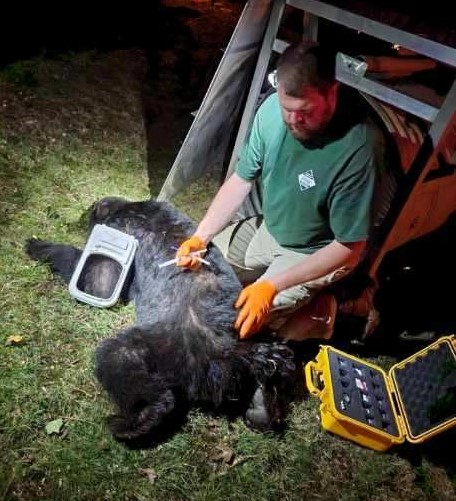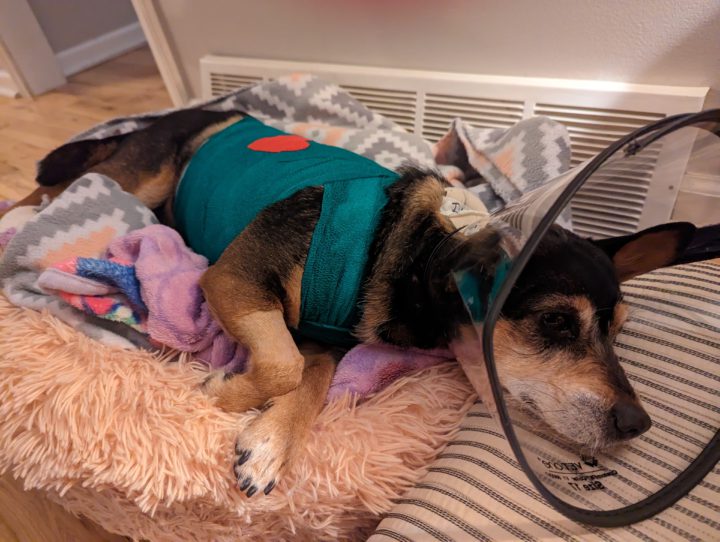When a small bear appeared on their porch April 3, Stacey Crowley and her wife, Babs Burlingame, were initially thrilled. After all, they’d moved from Chicago to a quiet neighborhood north of Weaverville in 2011 “specifically for more nature.” When the yearling cub made off with the 20-pound bag of birdseed they’d just purchased, Crowley and Burlingame’s enthusiasm waned, and after they spotted another cub eating from their birdfeeder, it vanished altogether.
Crowley and Burlingame had always viewed bear sightings as moments to savor. Previously, they’d filmed bears eating from their bird feeder and playing with their hose. Being on the other side of a window from the bears made them feel at ease. But their house, and the sense of infallibility it provided, had a weak point — the dog door — and they watched in horror as their dog, Ruby Biscuits, ran through it.
Crowley chased after Ruby out the front door, through the gate a fleeing cub had kicked open, and down the stairs. When she got to the bottom, she found the cub’s mother mauling her dog.
Humans tend to fight, flee or freeze in such situations. Crowley fought. She picked up a large piece of driftwood as if it were nothing and lifted it above her head. That’s the last moment she remembers until a car horn snapped her out of her stupor. Her neighbors were backing out of their driveway when they saw the bear stand on its hind legs and swipe at Crowley with its paws. After they honked, the bears scattered, and Crowley ran up the stairs, let Ruby onto the porch through the back gate and crumpled onto her kitchen floor.
The entire incident, from the moment Ruby Biscuits and Crowley ran out of the house to the moment the neighbors honked, lasted less than 20 seconds. In that time, Ruby suffered a broken rib, two puncture wounds and internal bleeding. Crowley came away with four long scratches on her left shoulder and four deep cuts on her scalp that had to be closed with staples.
The psychological toll would cut even deeper.
Predatory or defensive?
Asheville residents share photos and videos of bears on social media much as tourists in Paris post selfies in front of the Eiffel Tower. Bear mania reached a fever pitch here after the April 11 footage of local photographer David Oppenheimer coming face to face with a bear in his carport went viral. But not every human-bear encounter ends with heart emojis.
Just as Asheville’s population continues to grow, so has the number of bears in the area. At its low point in the 1970s, fewer than 1,000 black bears lived in Western North Carolina, but the management plan created by the N.C. Wildlife Resources Commission in 1981 helped the bear population recover — and then some. There are now an estimated 6,000 to 8,000 bears in the region, and the number has been increasing by about 5% each year.
Asheville’s bears have grown comfortable — some would say too comfortable — with city life, making frequent daytime visits to people’s backyards and becoming especially active on trash days. Like other black bear hot spots such as Aspen, Colo., and Tahoe, Calif., Asheville has started distributing bear-resistant garbage cans, but despite an ongoing rollout, only 4% of Waste Management customers have one.
Associating humans with easily obtained food, local bears have grown bolder, and the reports of bears damaging property or injuring people have soared. In 2017, the state’s Wildlife Helpline received 400 bear-related calls from Buncombe County. Last year, that number jumped to more than 700.
Fortunately, we’re starting to get a better picture of the local bear population, thanks to the N.C. Urban/Suburban Bear Study, which N.C. State University researchers started in 2014. They’ve found that Asheville’s bears are much bigger than bears living outside the city and females are breeding at a younger age and producing more cubs.
One of the main drivers of these changes is the bears’ dependence on “anthropogenic food sources,” such as birdseed and garbage. Justin McVey, the NCWRC’s wildlife management biologist for District 9, explained life in Asheville from the bears’ perspective. “They think, ‘Hey, wherever these two-legged creatures are is a great place to get food.’”
McVey’s job is to study “charismatic megafauna” such as bears, bison and elk, and at 6-foot-6, he likes to joke that he fits in that category as well. When an encounter with a bear sends someone to a local hospital, McVey investigates the incident. On April 4, he visited Crowley, listened to her story, studied the scene and determined that the bear’s behavior was defensive.
While McVey did point out the mistakes Crowley had made — “birdseed, dog off leash, going after her dog” — he spent more time offering support, an unexpected dose of empathy that Crowley calls his “special sauce.”
“This has been a trauma,” he told her. “I recommend you get some help. It’s going to get worse before it gets better.”
McVey returned two days later to install electric fencing around the deck. He also left her with an outdoor camera and some bear spray. But perhaps the most effective thing he did for her was introduce her to Jenny Camp.
A date to remember
During the three years she’d lived on the outskirts of Hendersonville, Jenny Camp had never seen a bear. That didn’t mean they weren’t around. She had three bird feeders in her front yard, and one of them got taken down and dragged into the woods one night. Like Crowley, Camp failed to see the disappearance of the bird feeder as a sign to change her behavior. She simply replaced it with a new one, and why not? Beyond losing that one feeder, she’d never had a problem with bears.
Until May 4, 2021. It’s easy for her to recall the date because it was Star Wars Day, and she’s a huge fan. An early riser, Camp woke before sunrise to let her dogs outside to do their business. Pepper went to the right of the house, Lulu to the left. Camp stood in the driveway so she could keep an eye on them, and in the faint light from the streetlight at the end of the driveway, she saw a bear charging at Lulu.
Camp started running toward her house but only made it as far as the porch steps before the bear knocked her down. As Camp rolled onto her back, she thought, “I wonder if they’re like cats? If I wiggle my feet, is it going to bite them?” Her next, more rational, thought was, “Get big, get loud.” Using every bit of her 5-foot-8-inch frame, she got up on her elbows and started screaming until the bear left.
Camp had landed hard on her right shoulder, but once inside the house, she noticed her left butt cheek hurt more. When she touched it, her hand came away with blood.
She called her husband, who was jogging in a church parking lot up the road, and he took her to the hospital. When they got home several hours later, McVey was already there. After hearing Camp’s story, he determined that the bear’s behavior wasn’t predatory. “Justin describes it as an exploratory bite,” Camp explained, “because if it had meant to do harm, it would’ve taken a chunk out of me.”
Worse than the bite was the psychological trauma. “For a long time, I wouldn’t go out the front door without sticking my arm out first and ringing a bear bell,” she said. “I used to go hiking but don’t anymore. I keep saying I’m going to but …” Her voice trailed off.
Hoping to prevent others from getting hurt, Camp posted about the incident on Hendersonville’s Facebook page. The post received the usual amount of social media bile as well as a large amount of vitriol specific to her encounter: “It’s your fault.” “You shouldn’t have been outside.” “Why wasn’t your dog on a leash?”
“There were over 200 comments, and 90% of them were awful,” she said. “To have that much hate poured on me was almost as traumatic as the bear incident.”
Perhaps if people had listened to Camp instead of yelling at her, another incident could have been prevented. On April 27, John Koerber had to use a walking stick to fight off a bear that lunged at his dog during a 4 a.m. bathroom trip. Koerber lives less than a mile, as the crow flies, from where Camp was mauled.
The dog component
What can be done to alleviate this growing problem? Relocation is not considered a viable option because true wilderness no longer exists near Asheville and relocated bears often return to the area where they were trapped — if they can avoid getting hit by a car.
One tried-and-true way of keeping the bear population in check is hunting. To that end, on Feb. 4, 2022, the NCWRC approved changing the name of the state’s 22 bear sanctuaries to “bear management units” and allowed bears to be hunted in three of them.
Another method is education. The second phase of the N.C. Urban/Suburban Bear Study is focusing on human-bear interactions and working with Asheville residents to prevent them. As part of this effort, the NCWRC is trying to educate the public through its BearWise program, which encourages people to limit activities that attract bears. Ashley Hobbs, NCWRC’s special projects biologist, is giving a BearWise talk at the East Asheville Library at 7 p.m. Tuesday, June 13.

In February, Asheville City Council passed an ordinance that empowers animal control officers to issue fines of up to $150 to those who feed bears, and yet people still do it. To reduce dangerous bear encounters, Asheville residents need to take responsibility for their role in creating the problem.
Stacey Crowley has had no problem doing this. In the time between Justin McVey’s first visit and his second two days later, she came to see her encounter with the bear differently. “The bear didn’t ambush me,” she told McVey. “It wasn’t a ‘bear attack.’ It was a ‘bear encounter that escalated due to provocation by a dog.’”
“That’s exactly right,” he said.
It was important to Crowley that she take ownership of her role in the incident. As a speech pathologist, literacy specialist and communicologist, a key component of the social-emotional learning skills Crowley teaches kids is the importance of taking responsibility for the choices they make. She found the story framework she uses with children to be especially helpful for her own recovery.
“I had to teach a 6-year-old about the bear attack because her mom told her, and I was like, ‘We wanted to watch the birds, but birdseed attracts bears, so we need to take the bird feeder down, and at last we’ll be safe.’”
Despite the electric fencing around her deck, Crowley found herself alternately crippled with fear and stuck in a daze for weeks after the incident. “It’s like a fog,” she said. “I couldn’t concentrate. Couldn’t focus. Couldn’t be motivated to do anything.”
Eye movement desensitization and reprocessing therapy helped. Finally, nearly a month later, the fog lifted. Now she’s slowly getting used to the new normal. For years, she and Burlingame would leave their doors open to let in a breeze. No longer. Their dog door remains permanently shut. And in a decision Crowley calls “heartbreaking,” they take down their bird feeder once the bears emerge from hibernation.
Of the six tips suggested by BearWise, people seem to find taking down their bird feeders the most difficult. The bears aren’t complaining. “A bird feeder can provide 12,000 calories of food,” said McVey. “It’s one-stop shopping for a bear.”
Crowley giving up her bird feeder half the year will only be effective if a critical mass of her neighbors follow suit. The same all-hands-on-deck approach is needed when it comes to garbage. “It only works if you have a bearproof garbage can, your neighbor has one, and their neighbor has one,” said McVey. “So, the question is ‘How can you convince everybody to do the right thing?’”
Storms Reback is an author and frequent contributor to the Mountain Xpress. He lives in East Asheville.





45 years on Beaucatcher Mountain where the old bear trail from the Blue Ridge parkway goes. No, I don’t like the bears and yes, they tried to attack my beloved shepherd in 2014 and he took down a standing mother with five cubs. While I was foolishly standing and screaming at the bear not to bother my dog. No food involved…the cubs were eating my oak tree to the ground. That dog is gone and now I have a puppy who cannot defend herself… no food ever put out in my property and garbage is frozen. People who love these animals can keep them on their yards. I’ll see what the electrified fence rules are.
We actually live much closer than a mile away from where Jenny Camp lived. We never saw any bears until 4 yrs ago and all of those encounters were just watching them walk through. We have informed ourselves on the
coexistence with them. Our small dog was leashed when I took him to pee at 4 am-an unusual time for him. I turned on the lights and made the usual voice to my dog. The bear ran out of the wooded area and made loud gutteral noises. I won’t go into the event again since it has been reported in the media. Both my dog and I were almost seriously injured.
Having him on a leash was critical.
I can understand the psychological effects that take hold afterwards. We are easing back into our yard, now with an air horn, and my usual walking stick. We are not venturing out at night with my dog. We did get bear spray as an added precaution.
My wife spoke to the lead at Help Asheville Bears and they went through all the particulars, He really couldn’t nail down the why of the attack. But he said that my actions were right on, especially given that I had been awakened by my dog and a bit groggy. Also, my wife had read Ms Camp’s post two years earlier and we recognized the close address. We did take note of it and told others. If the story can help another, the negative comments don’t bother me.
Bears reflect the bigger problem in Asheville…too many people are taking away animal’s habitats. It’s so easy to forget the animals, and the trees when people invade. “War is hell”.
oh god, those awful bears and their complete disregard for anything even remotely approaching civilized etiquette!
“ Like other black bear hot spots such as Aspen, Colo., and Tahoe, Calif., Asheville has started distributing bear-resistant garbage cans, but despite an ongoing rollout, only 4% of Waste Management customers have one.”
The “ongoing rollout” needs attention. We paid over $300 to buy a bear proof can, the latch broke, and waste Pro said they can’t help with fixing it, or replacing it because we bought it instead of renting it. We bought a better quality one from Lowe’s but last week it got bent being picked up by the truck and now won’t latch. I recommend people rent these so that at least waste pro will come replace it.
There’s no easy answer about what to do about the multiplying bears. Neutering all the cubs is an impossible task. Sadly their exposure to humans is making them more aggressive each year as they multiply. Never leave your pets unattended, even in a fenced yard. Keep bear spray and horns/whistles available outside. I also carry on walks.